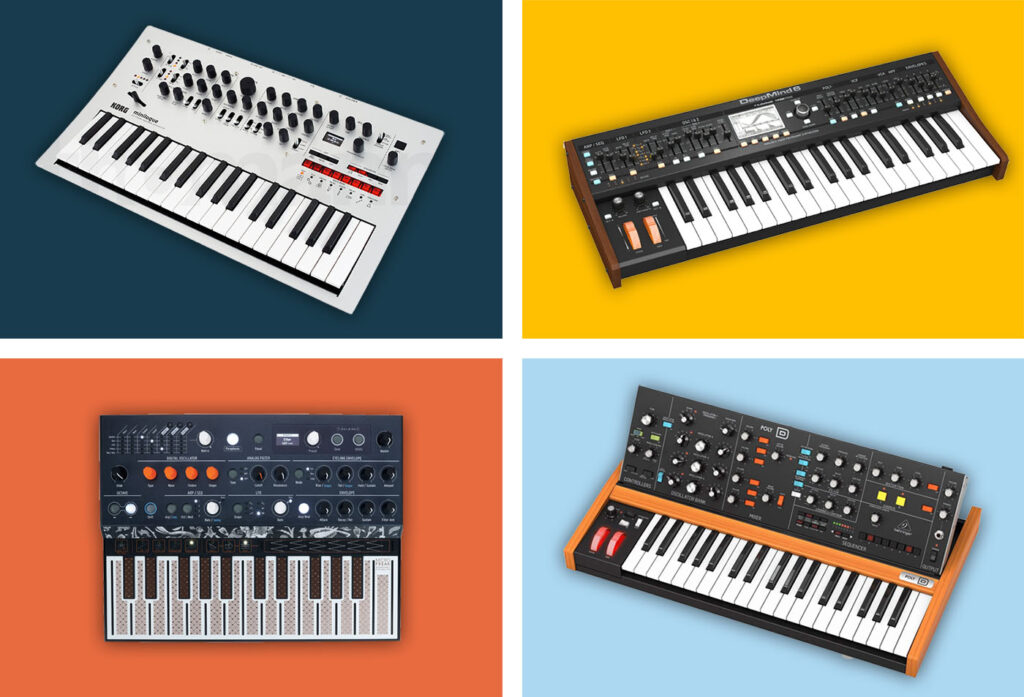What is a synthesizer?
A synthesizer is an electronic musical instrument that uses electronic circuits to produce sounds. It can be used to imitate acoustic instruments such as the piano, strings, and wind instruments, as well as to create entirely new, synthetic sounds.
Unlike traditional instruments, which produce their sounds through mechanical vibrations/waves, a synthesiser produces its sounds by manipulating electronic signals. This can be done in a number of ways, but the best known and most widely used is through oscillators, which produce continuous signals.
How does a synthesizer work?
Synthesizers are capable of reproducing the sounds of real instruments (trumpet, Electric guitar, Bass guitar etc.) or creating completely new, extravagant sounds that do not resemble any analog instrument.
All synths work on the same principle, only the way the waves are generated is different. Classic synthesizers use analog oscillators, but there are other methods of synthesis such as digital oscillators or sample-based synthesis - more on this later.
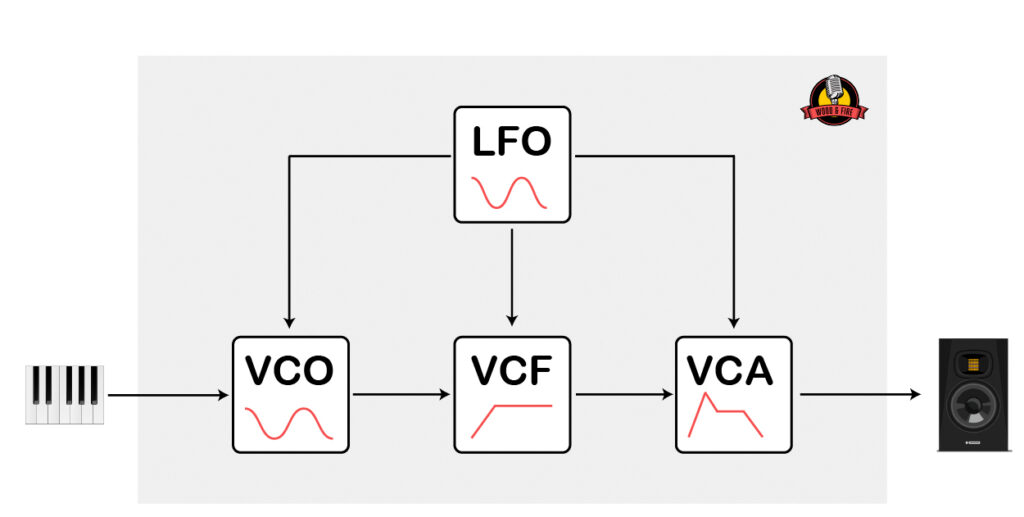
- Oscillator (VCO): The process usually starts with an oscillator, also called a VCO (Voltage Controlled Oscillator), which creates a basic waveform. These waveforms can have different shapes (e.g., sine, saw, square, and triangle), each of which has its own unique sonic characteristics. The frequency of this waveform determines the pitch of the resulting sound.
- Filter (VCF): The signal generated by the oscillators is often passed through one or more filters (VCF or Voltage Controlled Filter).These filters can boost or cut certain frequency ranges of the signal, changing the timbre or color of the sound. For example, a low-pass filter allows frequencies below a certain threshold to pass, while a high-pass filter allows frequencies above a certain threshold to pass.
- Amplifier (VCA):After the signal passes through the filters, it is usually sent through an amplifier (CA or Voltage Controlled Amplifier), which controls the volume of the sound. Volume is often controlled by an ADSR envelope, which determines how the sound rises and falls.
- Modulation (LFO): Many synthesizers also allow for modulation, in which some aspect of the sound (such as pitch, timbre, or volume) is changed over time. This can be done using Low Frequency Oscillators (LFOs), which produce slow oscillations that can be used for modulation, or other methods such as envelopes.
- Mix and combination: In many synthesizers, multiple oscillators, filters, and other components can be used and mixed in various combinations to expand the sonic palette. This is often where the true creativity and flexibility of a synthesizer comes into play.
Synthesizers are so popular because they allow any artist to create a unique, completely new sound - you literally create your own sound. That's why there are true synthesizer enthusiasts who own extremely expensive setups and are able to create all kinds of sounds.
However, it can be very difficult for beginners to create a usable sound without presets if you have no experience in the world of sound synthesis - you need a certain amount of experience to know roughly what you should be trying to achieve. But that comes with practice!
Keep reading: What is a vocoder? Functionality, history and best models
Different synthesis methods
As mentioned above, there are several synthesis methods that can be used instead of or in combination with a VCO, each with its own sound.
Analog synthesizer
Analog synthesizers use analog electronics and oscillators to generate and manipulate electrical signals that are then converted into sound. Oscillators create a basic waveform (e.g., sine, sawtooth, square) that is then modified by various sound processing stages such as filters (for sound shaping) and amplifiers (for volume control). Analog synthesizers are known for their "warm" and "fat" sound.
FM synthesizer
FM synthesizers produce sounds by frequency modulating a waveform with another high-frequency oscillator, creating complex timbres. The principle of operation is similar to the modulation of an oscillator in an analog synthesizer, but the modulation frequencies in FM synthesizers are in the high, audible range, while the modulation frequencies in classic synthesizers are much lower.
This type of synthesis was popularized by the Yamaha DX7 in the 1980s, which produced a whole range of previously unknown sounds. FM synthesis can be more difficult to understand and program than other methods, but it allows for an enormous variety of sounds.
Sample-based synthesizers
Sample-based synthesizers, sometimes called "rompers," create sounds by playing and modifying recorded audio samples. These samples can be real instruments, voices, ambient sounds, or other sources. The samples can then be pitched, filtered, envelope modulated, and otherwise manipulated to create different sounds. A well-known example of a sample-based synthesizer is the Korg M1.
Wavetable synthesizer
Wavetable synthesis is based on the idea that you have different waveforms (from samples) in a table - hence the name "wavetable". The synthesizer can play these waveforms, or "morph" (gradually change from one waveform to another) between them. Each waveform in the table has a unique sound, and morphing between waveforms can create complex sounds.
Digital synthesizer
Digital synthesizers use digital signal processors (DSPs) to create and modify sounds. These sounds can be based on various synthesis methods, including digital emulations of analog synthesis methods (digital VCOs), samples, but also specific digital methods such as FM synthesis or wavetable synthesis. An advantage of digital synthesizers is their versatility and their ability to produce a great variety of sounds by combining all possible synthesis methods.
Monophonic vs polyphonic vs paraphonic synthesizers

A monophonic synthesizer can only produce one note at a time. This means that if you play one note and then another while still holding down the first note, the first note will be cut off and only the second note will sound. Monophonic synthesizers are often used for bass lines or leads because they often have a powerful and assertive sound - but they can't play chords.
A polyphonic synthesizer can produce multiple sounds simultaneously, each sound using its own components (its own VCO, VCA, LFO). This means that multiple sounds can be played simultaneously to create chords or complex melodic structures. The number of notes that can be played simultaneously depends on the synthesizer model: some can play only a few notes, while others can produce dozens or even hundreds of notes. Polyphonic synthesizers are often used for pads, strings, choirs, and other "filling" soundscapes.
In addition to monophonic and polyphonic synthesizers, there are also paraphonic synthesizers. A paraphonic synthesizer can play multiple notes simultaneously, but they share some or all of their sound-generating components (such as filters and ADSR amplifiers), making it a kind of "middle ground" between monophony and polyphony.
In practice, paraphony is noticeable when you play a chord on a paraphonic synthesizer and then change one of the notes in the chord. In this case, the sound of the entire chord changes because the single filter applied to all the notes reacts to the new note. With a polyphonic synthesizer, on the other hand, only the sound of the changed note changes, while the other notes remain unchanged, since each note has its own filter.
The best synthesizers for beginners
If you want to get started in the world of synthesizers, it can be hard to choose from the huge amount of models available. Here I've rounded up the most popular synthesizers for beginners to help you choose.
One thing up front: It is important to have a lot of patience when you start working with synthesizers (especially with pure analog synthesizers without presets), because the sounds that come out at the beginning are not very nice. Before you can even play a melody, you have to spend a lot of time generating sounds, and that can take a long time in the beginning.
Behringer Poly D
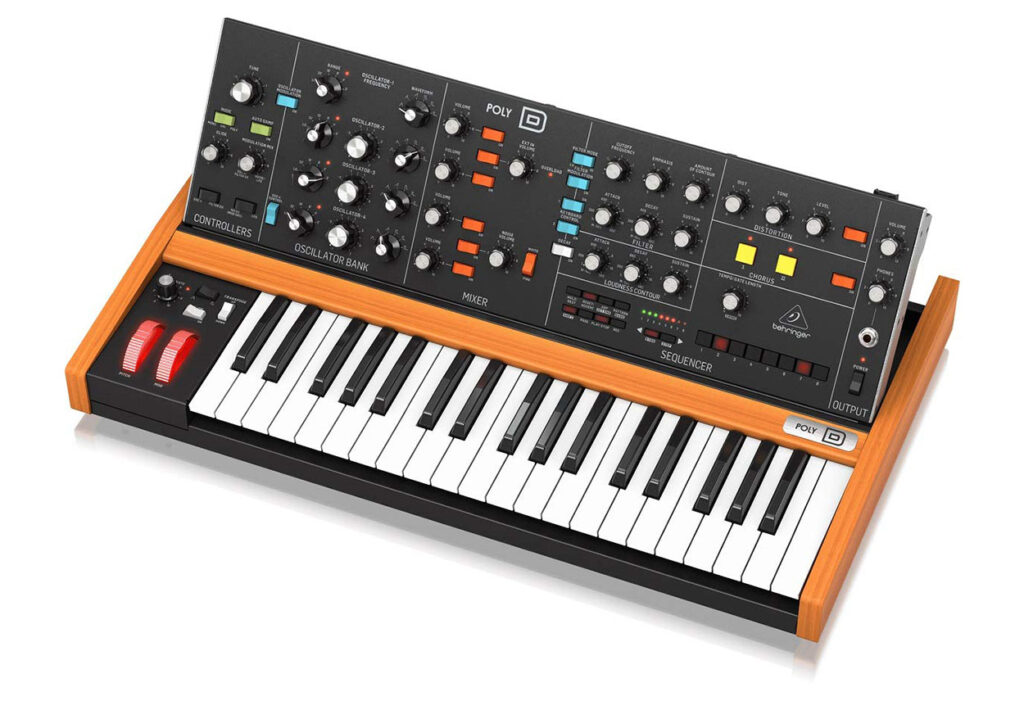
The Behringer Poly D is an ambitious reinterpretation of the classic Minimoog Model D, widely regarded as one of the most famous monophonic synthesizers. However, with its 4-voice paraphonic capabilities, the Poly D breaks the mold and opens up a whole new dimension of possibilities for those familiar with its monophonic predecessor.
At the heart of the Poly D are its four VCOs, each capable of generating three waveforms (and combinations thereof): Triangle, Sawtooth and Pulse. The four VCOs give the Poly D its paraphonic capabilities, meaning it can play up to four notes simultaneously - a feature not found on the original Minimoog Model D.
When playing 4 notes simultaneously, each oscillator produces a note, but all notes pass through the same filter and ADSR. This can be annoying in certain situations, such as playing a new note while holding down another.
If you set the envelope of the amp to a slow attack and a long release, the second note you play will start without the slow attack because the single VCA is still busy with the first note.
For sound shaping, the Poly D has a classic 24dB ladder filter that gives the synthesizer its warm, full and fat Moog sound. There are also two envelopes for the VCA and VCF for even more sound shaping possibilities.
Of particular interest are the built-in chorus and distortion effects. They expand the sonic spectrum of the Poly D and make it possible to add even more fullness, width and sharpness to the sound.
Price: 528€, Link: Behringer Poly D
Behringer DeepMind
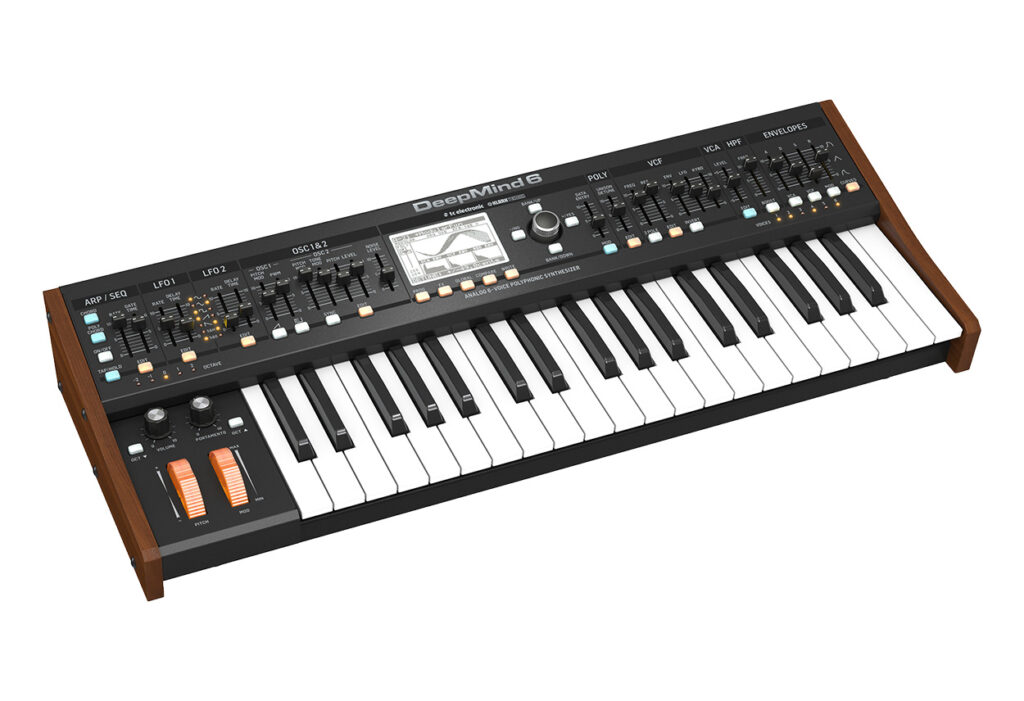
An impressive blend of traditional analog synthesis and modern digital technology, the Behringer DeepMind is perfect for beginners looking to enter the world of synthesizers.
At the heart of the DeepMind are six (DeepMind 6) or twelve (DeepMind 12) analog DCOs (digitally controlled oscillators) capable of producing some very beautiful sounds. Each voice has two oscillators, a noise generator, and two LFOs, giving you plenty of options to create unique and complex sounds.
This synthesizer is truly polyphonic, i.e. each voice has 2 oscillators, its own VCF and its own VCA. So you can play chords without any problems and all notes sound the same, no matter if they are played simultaneously or delayed.
A real highlight of the DeepMind, however, is its 2- or 4-pole resonant low-pass filter, which is inspired by the classic Roland Juno-106 and delivers a warm, musical quality that is hard to find in other synthesizers at this price point.
The synthesizer also shines in the effects department, offering a selection of over 30 different effects, including reverb, delay, chorus, phaser, EQ, and more, developed in collaboration with renowned effects specialists TC Electronic and Klark Teknik. With the ability to use up to four effects per voice simultaneously, the DeepMind creates a dense, atmospheric sound that shines in the studio and on stage.
Price: 579€, Link: Behringer DeepMind 6
Korg Volca Keys
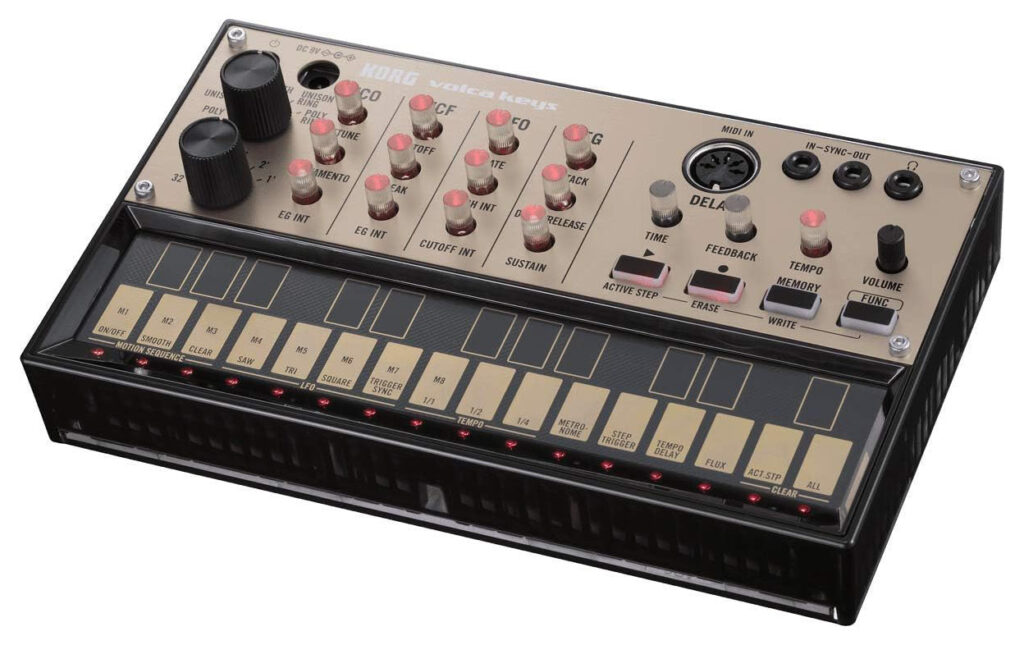
The Korg Volca Keys is an impressive piece of hardware for its size and price, and proves to be the perfect entry into the world of synthesizers. It is a fully analog, polyphonic synthesizer that offers an amazing variety of sounds despite its compact size and entry-level price.
At the heart of the Volca Key are three oscillators, a VCF, an LFO and a VCA. Each of these elements is simple, without a lot of bells and whistles - but they are able to perform their core function perfectly. There is also a simple delay effect that adds depth to the sound.
Another cool feature of Volca Key is the built-in sequencer. This allows you to create and play patterns and melodies in real time or step by step. This is a great way for beginners to learn the principles of sequencing and melody composition.
The built-in keyboard is not the best in my opinion, but for the low price you can't expect a perfect synth either. Fortunately, you can connect your own MIDI keyboard via MIDI IN and play the synth with it.
Highly recommended if you want to familiarize yourself with the principles of analog sound synthesis.
Price: 159€, Link: Korg Volca Keys
Korg Minilogue
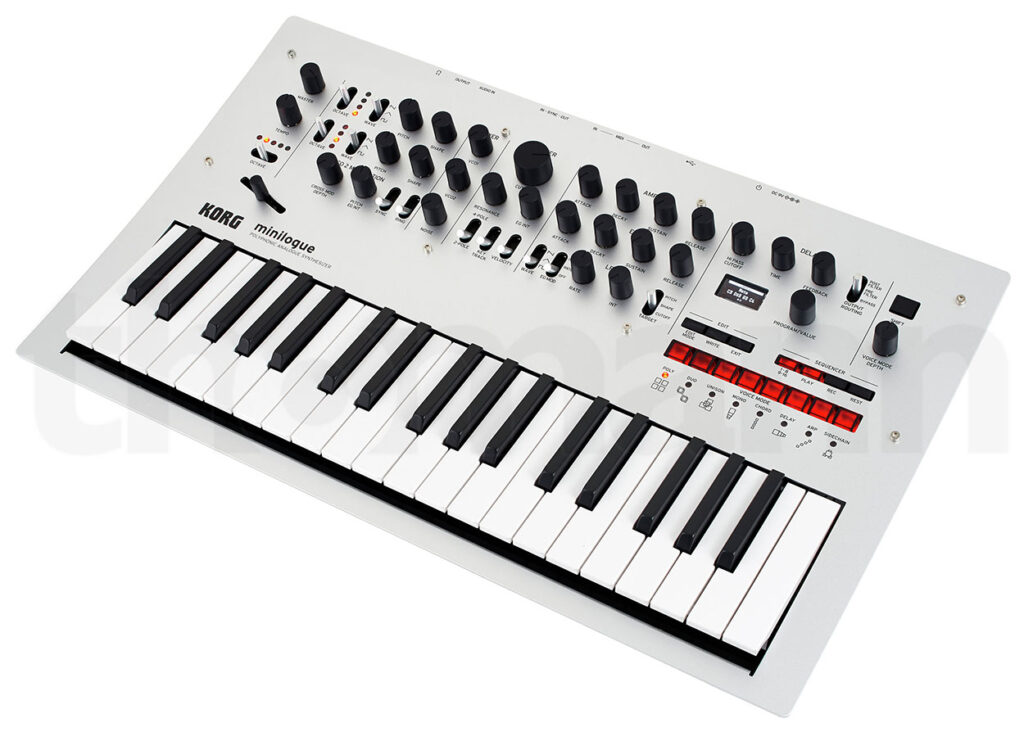
The Korg Minilogue is a remarkably intuitive and flexible synthesizer that is an excellent choice for both beginners and advanced musicians. With its 4-voice polyphony, sturdy metal case, and attractive price/performance ratio, the Minilogue has a lot to offer.
What makes the Minilogue such an interesting synthesizer is its versatility. The combination of analog oscillators and digital control opens up many possibilities. With two VCOs (Voltage Controlled Oscillators) per voice, a resonant low-pass filter, and a variety of modulation options, the Minilogue offers enough options to create all kinds of sounds.
This synth is 4-voice polyphonic, which means that 2 oscillators, VCF, VCA and modulation are available for each of the 4 voices. This makes it possible to play beautiful chords as well as complex polyphonic melodies without any restrictions - except of course the number of voices, which is limited to 4.
For beginners, one of the most attractive features of the Minilogue is its intuitive and well-organized layout. Each parameter has its own dedicated knob, so there's no need to click through confusing sub-menus. This allows beginners to jump right into synthesis and quickly develop an understanding of how the different parameters affect the sound.
Price: 519€, Link: Korg Minilogue
Arturia MicroFreak
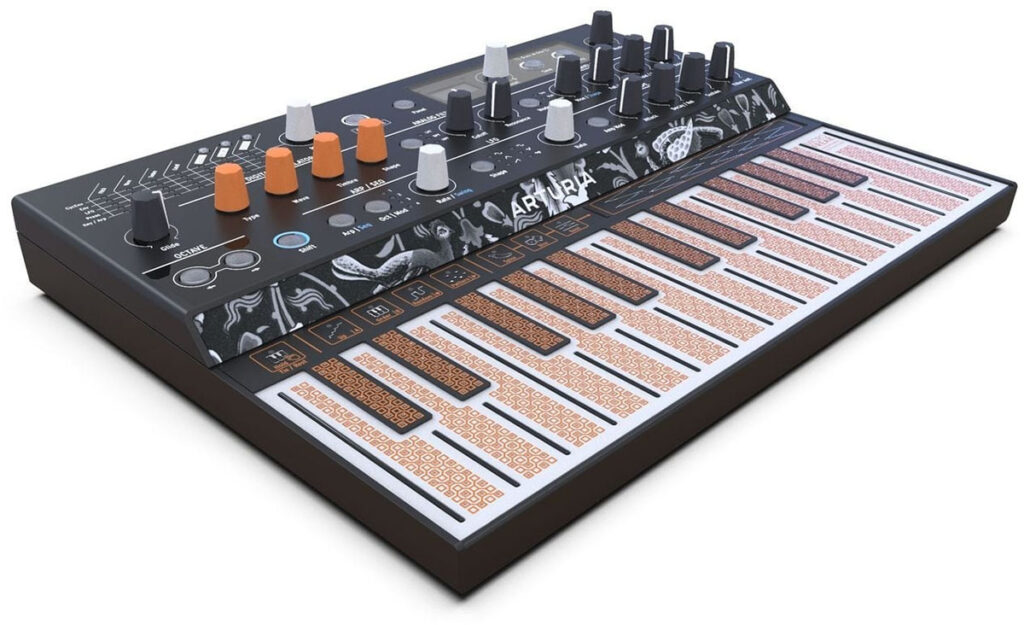
The Arturia MicroFreak is an exceptional and unique synthesizer that is perfect for producers looking to embark on a creative and innovative musical journey. Combining the elements of a traditional analog synthesizer with digital synthesis, it offers an extremely wide range of features in a compact package at an unbeatable price.
At the heart of the MicroFreak is a highly versatile digital oscillator with numerous synthesis modes. From wavetable and granular synthesis to virtual analog synthesis and unusual synthesis methods such as Karplus Strong, Harmonic OSC, Superwave or Texturer, the MicroFreak offers an impressive variety of sounds.
This way, even beginners can try out different synthesis techniques and understand what would otherwise only be possible with several separate instruments.
A unique feature of the MicroFreak is its PCB keyboard. Unlike traditional synthesizer keyboards, this capacitive surface responds not only to touch but also to pressure, resulting in very expressive playing.
The modulation possibilities are enormous, because the synthesizer offers a modulation matrix with 5 sources and 7 destinations. This allows you to modulate virtually any parameter. A small OLED display provides visual feedback and makes it easy to navigate through the menus.
Price: 339€, Link: Arturia MicroFreak





